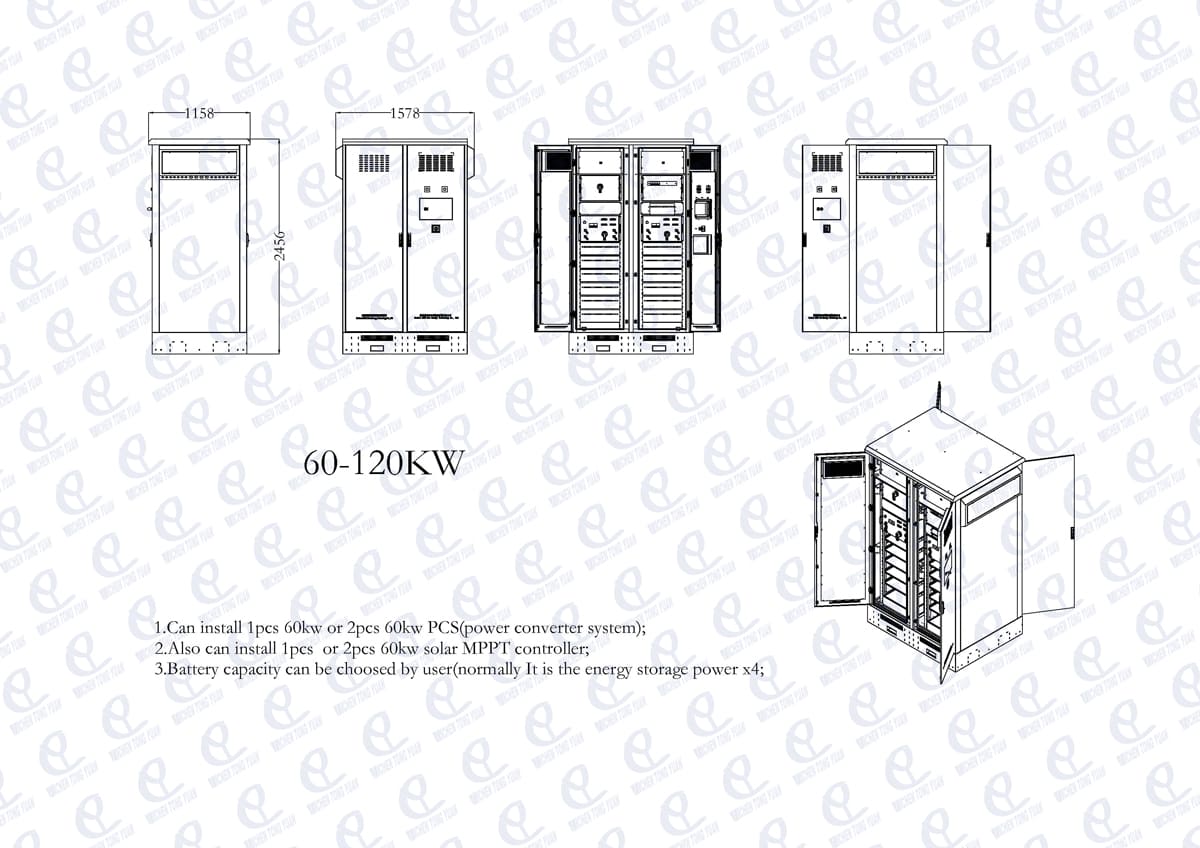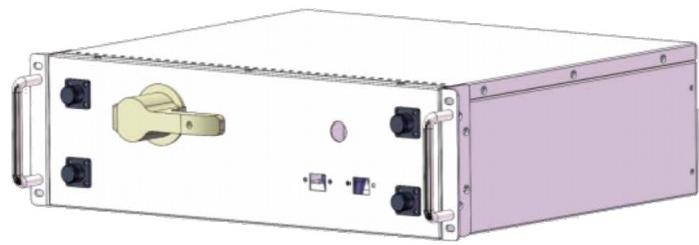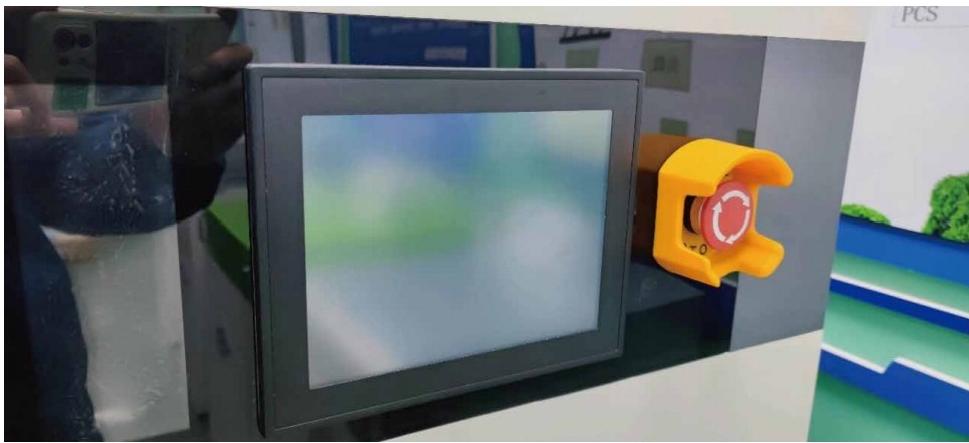Industrial and Commercial Energy Storage System Video
Industrial and Commercial Energy Storage System Introduction
Industrial and commercial energy storage system is a system that can store electric energy and supply power, with smooth transition, peak shaving and valley filling, frequency and voltage regulation and other functions. It can smooth the output of solar and wind power generation, and reduce the impact of its randomness, gap and fluctuation on the power grid and users; Charging in the valley price period and discharging in the peak price period can reduce the user's electricity expense; In case of power failure in the large power grid, it can operate independently to ensure uninterrupted power supply to users.
Industrial and Commercial Energy Storage System Parameter
ESS | 30KW | 60KW |
Scalable maximum power | 90KW | 180KW |
Battery capacity | 87.92 KWh | 163.84 KWh |
Rated grid voltage | 230/400V 3P+N+PE |
Rated grid frequency | 50HZ |
Size(W*D*H) | 789*1180*2450mm | 1577*1180*2450mm |
Installation conditions | Outdoor | Outdoor |
Protection level | IP55 | IP55 |
Working humidity range | 0%~95%(non-condensing) |
Working temp range | -30℃~+50℃(>45℃,wil Derate) |
Communication interface | CAN, RS485 |
Battery cell brand | LFP(EVE) |
Discharge rate | 1C |
Single battery capacity | 5.12KWh |
Battery quantity | 16 | 32 |
Energy Storage System Cabinet Drawing

System Components of Industrial and Commercial Energy Storage System

Battery management system(BMS) for Industrial and Commercial Energy Storage System

According to the system communication capability and system security, the battery management system adopts a three-layer architecture. The slave control collects the voltage and temperature of each unit. The master controller obtains the slave control data, voltage and current through communication.
Name | Parameter |
System power | DC24V |
Single cell voltage detection range | 0V~5V |
Single cell voltage detection accuracy | ±5mV |
Temperature detection range | 40℃~85℃ |
Temperature detection accuracy | ±1℃ |
Total voltage detection range | 0V~1000V |
Total voltage detection accuracy | 1%FSR |
Insulation detection | Support the maximum voltage of 1200V, and the detection error is less than 10% |
Current detection range | -300A-300A |
Current detection accuracy | 1%FSR |
SOC accuracy | 6% |
Equalizing current | 100mA |
Communication interface | CAN, RS485 |
Overload protection | Over-charge, over-discharge, over-temperature, short circuit and other protection, and the protection setting can be set |
Industrial and Commercial Energy Storage System Converter(PCS)

In the energy storage system, in addition to the bidirectional inverter function, the energy storage converter can also support the power grid, ensure the stable operation of the power grid system, provide the ability to withstand short-term impact, smooth power supply, energy storage, peak shaving and valley filling.
Model | 30KW | 60KW |
DC side parameters | Max voltage | 1000V | 1000V |
Rated voltage | 800V | 800V |
Working voltage range | 680~1000V | 680~1000V |
Max charge/discharge current | 44A | 88A |
AC grid connection parameters | Max input apparent power | 30KVA | 60KVA |
Max input active power | 30KW | 60KW |
Rated input voltage | 230/400VAC,3P+N+PE | 230/400VAC,3P+N+PE |
Max continuous input current | 43A | 86A |
Rated input frequency | 50Hz | 50Hz |
AC off-grid parameters | Rated output voltage | 230/400VAC,3P+N+PE | 230/400VAC,3P+N+PE |
Rated output frequency | 50Hz | 50Hz |
Max continuous output current | 43A | 86A |
Max output active power | 30KW | 60KW |
Max output apparent power | 30KVA | 60KVA |
General parameters | Unbalanced load capacity | 100% | 100% |
power factor | >0.98 | >0.98 |
Working temperature range | -30~+60℃(>45℃,wil Derate) | -30~+60℃(>45℃,wil Derate) |
Max efficiency | 98.5% | 98.5% |
AC/DC start function | YES | YES |
Dimensions (W* D* H) | 436*550*130mm | 436*550*130mm |
Weight | 25kg | 28kg |
MPPT Controller Module

The power module of MPPT controller adopts the latest optimized hardware design and advanced control algorithm, which has intelligent control and high reliability.
Model | 30A | 60A |
PV side parameter |
Max input component power | 42KW | 84KW |
Max input voltage | 1000VDC | 1000VDC |
MPPT voltage range | 200~850VDC | 200~850VDC |
Starting voltage | 200VDC | 200VDC |
MPPT | 1 | 1 |
PV way | 1 | 1 |
Max input current | 100ADC | 200ADC |
DC side parameter |
Max DC voltage | 1000VDC | 1000VDC |
Rated voltage | 800VDC | 800VDC |
Voltage range | 350~1000VDC | 350~1000VDC |
Max continuous current | 50ADC | 100VDC |
Max continuous power | 30KW | 60KW |
Dimensions (W* D* H) | 436*550*130mm | 436*550*130mm |
Weight | 25kg | 30kg |
Energy Management System(EMS)

In the Industrial and Commercial Energy Storage System, the EMS communication topology is divided into two layers. The top layer is the general centralized monitoring system.
Bottom equipment: energy storage converter, battery management system (BMS), environmental monitoring equipment, fire protection system, air conditioning or access control system, etc. are all connected to the monitoring system (currently with administrator authority management, soft access control).
The monitoring host completes the network connection, conversion, data acquisition, data local processing, protocol conversion and command exchange between the on-site monitoring and control systems, local user screen monitoring operation, control strategy, and WEB server functions, and realizes the high-speed collection and transmission of large-capacity real-time data, so as to ensure that the master station system can quickly and accurately obtain all monitoring and monitoring information, and timely feed back the system abnormalities and faults detected by the network, Ensure fast positioning and recovery. (It needs to be realized through station-level BMS)
Example of Selecting Scalable Solutions for Energy Storage Systems
PCS power | MPPT power | Battery capacity | BMS | EMS | Air conditioner | Fire extinguisher system | Cabinet QTY |
30KW | 30KW | 81.92KWH | 1 | 1 | 1 | 1 | 1 |
60KW | 60KW | 163.84KWH | 1 | 1 | 2 | 1 | 1 |
120KW | 60/120KW | 163.84KWH | 1 | 1 | 2 | 1 | 1 |
180KW | 120/180KW | 409.6KWH | 1 | 1 | 4 | 2 | 2 |
240KW | 180/240KW | 635.36KWH | 1 | 1 | 6 | 3 | 3 |
30kw energy storage System list
Equipment Name | Specification parameter | Unit | Qty | Remark |
PCS | 30kw | pcs | 1 |
|
MPPT | 30kw | pcs | 1 |
|
Lithium battery | 81.92kwh(5.12kwh/pcs) | pcs | 16 | option |
Air conditioner |
| pcs | 1 |
|
Fire Extinguisher |
| pcs | 1 |
|
EMS |
| pcs | 1 |
|
Solar panel | 440W/pcs | pcs | 64 | option |
Cabinet |
| Pcs | 1 |
|
Power distribution and auxiliary materials |
| set | 1 |
|
60kw energy storage System list
Equipment Name | Specification parameter | Unit | Qty | Remark |
PCS | 60kw | pcs | 1 |
|
MPPT | 60kw | pcs | 1 |
|
Lithium battery | 163.84kwh(5.12kwh/pcs) | pcs | 16 | option |
Air conditioner |
| pcs | 2 |
|
Fire Extinguisher |
| pcs | 1 |
|
EMS |
| pcs | 1 |
|
Solar panel | 440W/pcs | pcs | 128 | option |
Cabinet |
| Pcs | 1 |
|
Power distribution and auxiliary materials |
| set | 1 |
|








































